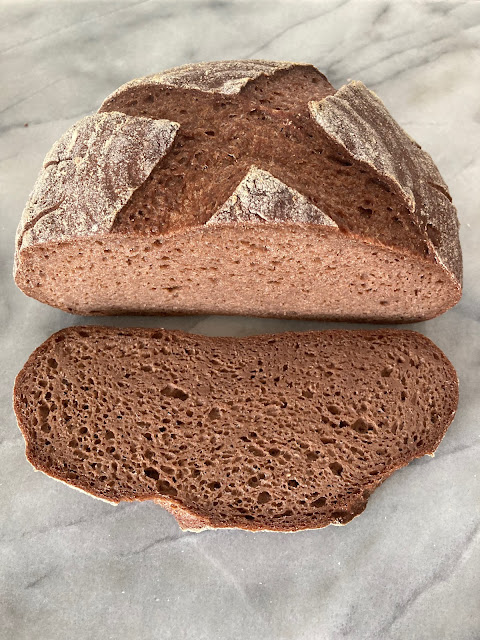Specialty Flours for Gluten-free Baking
Last month I wrote a post about basic gluten-free flours: their properties, their uses, their virtues, and their downsides. Here is the promised extension to that original post, which hopes to shed some light on some other more specialized GF grains.
Amaranth flour (also known as Inca wheat or quihuicha): This flour behaves quite a bit like sorghum flour, and has a lot of flavor. It is a grain high in protein and very nutritious. A dough made with amaranth is very delicate, wet, and tricky to handle. I only use a small portion of this flour in my all-purpose mixes for the flavor it adds.
Buckwheat flour: a close relation to rhubarb, this grain is in no way related to the wheat family. It is a very dark flour with a strong, distinctive and pleasant nutty flavor. The flour has a very fine grit, and can be used in making whole-grain products. It does not behave well on its own, producing very dry and brittle product unless it is mixed with other flours. I usually recommend subbing 1/4-1/3 of your flour mix for buckwheat flour if you want to take advantage of its flavor and texture in your recipe.

Corn flour: This is simply a finer grind of corn meal. Bob's Red Mill has a very good corn flour with a fine texture. This flour still retains a little bit of a hard kernel to it, however. It is a very dry-textured flour and can be cut with a lot of high-starch flours. I avoid using corn in my all-purpose GF mixes because of its texture and because it is an allergen for many people with gluten sensitivity.
Masa harina: This is a corn flour used primarily in Mexican cooking for making corn tortillas, tamales, and sopes. It differs from corn meal in that it has been nixtamalized, or processed with lime, which makes it easier to work with and digest. I have not yet experimented with using this kind of corn flour as a substitute for corn meal, so if anyone has input let me know!
Quinoa: This plant is related to spinach. The flour made from its seeds is very high in protein. The flour is fairly versatile, is not gritty, and has a neutral flavor. The flour seems to behave a lot like corn flour, though it is not quite as hard and dry as corn to work with.
Teff (or tef): This flour is traditionally made into injera, a bread of Ethiopia. The bread has a very spongy, springy texture and holds together very well. It has a medium-brown color and a distinctive flavor that is not universally appealing, but if you like sourdough bread, you will probably like injera.
What are your favorite flours? What experiences do you have in using the flours listed here? Please share your thoughts on gluten-free baking!
Amaranth flour (also known as Inca wheat or quihuicha): This flour behaves quite a bit like sorghum flour, and has a lot of flavor. It is a grain high in protein and very nutritious. A dough made with amaranth is very delicate, wet, and tricky to handle. I only use a small portion of this flour in my all-purpose mixes for the flavor it adds.
Buckwheat flour: a close relation to rhubarb, this grain is in no way related to the wheat family. It is a very dark flour with a strong, distinctive and pleasant nutty flavor. The flour has a very fine grit, and can be used in making whole-grain products. It does not behave well on its own, producing very dry and brittle product unless it is mixed with other flours. I usually recommend subbing 1/4-1/3 of your flour mix for buckwheat flour if you want to take advantage of its flavor and texture in your recipe.

Corn flour: This is simply a finer grind of corn meal. Bob's Red Mill has a very good corn flour with a fine texture. This flour still retains a little bit of a hard kernel to it, however. It is a very dry-textured flour and can be cut with a lot of high-starch flours. I avoid using corn in my all-purpose GF mixes because of its texture and because it is an allergen for many people with gluten sensitivity.
Masa harina: This is a corn flour used primarily in Mexican cooking for making corn tortillas, tamales, and sopes. It differs from corn meal in that it has been nixtamalized, or processed with lime, which makes it easier to work with and digest. I have not yet experimented with using this kind of corn flour as a substitute for corn meal, so if anyone has input let me know!
Quinoa: This plant is related to spinach. The flour made from its seeds is very high in protein. The flour is fairly versatile, is not gritty, and has a neutral flavor. The flour seems to behave a lot like corn flour, though it is not quite as hard and dry as corn to work with.
Teff (or tef): This flour is traditionally made into injera, a bread of Ethiopia. The bread has a very spongy, springy texture and holds together very well. It has a medium-brown color and a distinctive flavor that is not universally appealing, but if you like sourdough bread, you will probably like injera.
What are your favorite flours? What experiences do you have in using the flours listed here? Please share your thoughts on gluten-free baking!



Comments
I didn't know quinoa was in the same family as spinach! You learn something new everyday...
Brown rice flour seems to add a nice flavor, but it doesn't do a very good job of turning to dough, so it needs to be mixed with something else. My favorite brown rice flour recipe: http://glutenfreegoddess.blogspot.com/2006/01/dark-chocolate-brownies.html I'm also sensitive to sugar and dairy, so I substitute unsweetened chocolate and agave for the chocolate, and fructose for the brown sugar. Super yummy!!